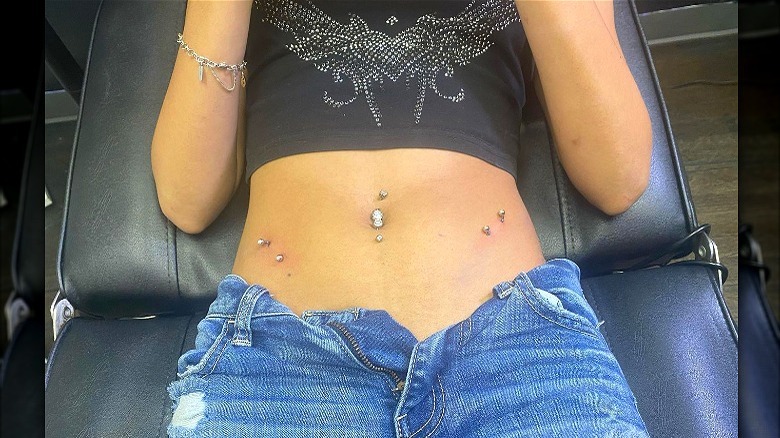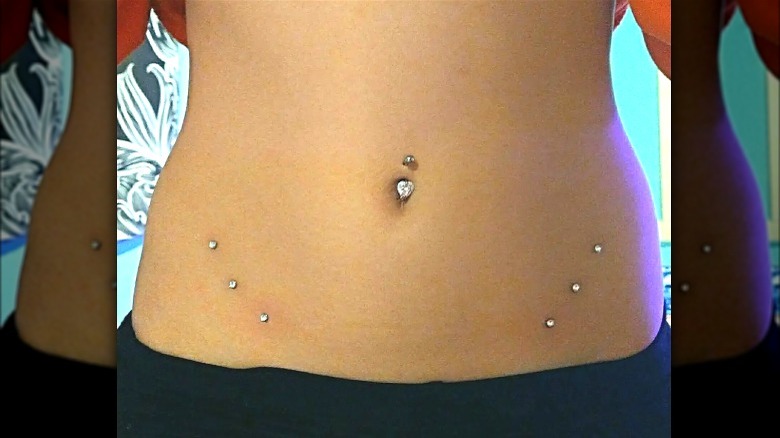What To Know Before You Get A Hip Piercing
It seems like more and more people these days are opting for body bling. According to the advocacy group Support Tattoos and Piercings at Work, about 83% of Americans have had their ear lobes pierced, while 61% have had some form of body or ear cartilage piercing. Besides ear lobes, the navel and nose are the most popular piercings for women to get. These piercings look stylish and are becoming more socially acceptable, but they might not seem unique enough for someone who really wants to turn heads. If you want a new piercing that helps you stand out from the crowd, a hip piercing could be just the thing.
Hip piercings are a unique and sexy body modification that you don't see much in everyday life. They can be done on one or both sides of your hips, look great with a navel ring, and add a lot of personality to any belly-baring outfit. For some people, a hip piercing can boost their self-esteem and help them feel more confident in a swimsuit or in the bedroom. Still, these piercings are a big decision, and they aren't exactly low-maintenance. Whether you're planning to get your first body piercing or your 15th, here's what you should know before getting a hip piercing.
Going under the needle
Before you start to feel woozy, no, hip piercings don't pierce through the actual hip bone. They're dermal piercings that use either a curved or U-shaped barbell, or a single dermal rhinestone with a hook. These piercings pass through several layers of skin on the lower abdomen, just above the hip bones. According to jewelry retailer BodyJ4You, hip piercings and other dermals fall around a medium on the pain scale, somewhere between a belly button and a nipple or genital piercing. Of course, everyone's pain tolerance is different, so what might feel like a ring of fire to someone else could just feel like a slight pinch to you!
If you decide you want a hip piercing, it's extremely important to go to the right place to have it done. Don't trust your tipsy friend to do this one in their garage. Instead, look for a reputable tattoo shop near you and ask when their piercer will be available. Most hip piercings cost between approximately $40 and $100. Before your appointment, make sure you're well-hydrated and you've eaten, as low blood sugar can cause some people to feel lightheaded. Your piercer will assess your anatomy to determine which kind of jewelry will work best for you. They'll clean the area, mark the piercing site with ink, then quickly pierce your skin and insert the jewelry. If you're feeling nervous, bring a friend so you can squeeze their hand!
Hip piercing aftercare and styling
The actual piercing process should only take a few minutes, but your effort doesn't end there; aftercare is extremely important to ensure your shiny new piercing heals correctly. Before you rush out the door, listen to your piercer's instructions for cleaning and protecting your piercing. In general, a hip piercing will take at least two to six months to heal with a dermal hook, and up to a year or longer with a dermal bar (via Infinite Body Piercing). During that time, you'll need to avoid touching the piercing or submerging it in water, and always wash your hands before cleaning it twice daily with saline solution. If you ever decide to remove your piercings, they will close up rather quickly and could leave a scar. For this reason, it's best to visit your piercer when you want to change the jewelry, rather than trying to do it yourself at home.
This might seem like a lot of work for a little bling, but for many people, the results are totally worth it! There are lots of cute jewelry options for hip piercings, from classic silver and gold to colorful rhinestones and even dangly chains. Hip piercings look amazing when styled with the low-rise pant trend and crop tops. Of course, they're also super eye-catching in a swimsuit, so get ready to slay your piercings in a bikini this summer — after they've healed, of course!


